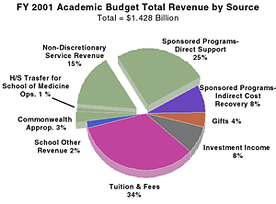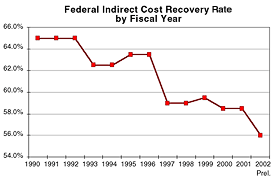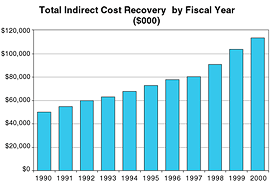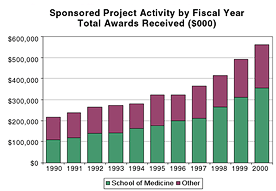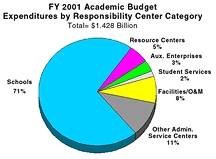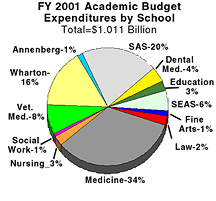
Budget 2000-2001: President Rodin's Report to the University Council
President Rodin's report to Council on March 28 included the University's financial planning approach and the components of the University budget. The pie charts show the academic budget revenue by source as well as the expenditure budget.
Additionally, the charts highlight the challenges the University faces as well as goals to be achieved in light of fiscal constraints.
The tables, pies, graphs and text are from the slide presentation.
Components of the Consolidated University Budget
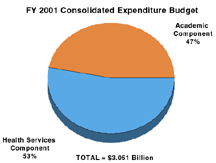 The Consolidated University budget has two major
components--"Academic" and "Health Services"
The Consolidated University budget has two major
components--"Academic" and "Health Services"
- The Academic budget includes:
- --Schools (including the School of Medicine)
- --Resource Centers
- --Auxiliaries
- --Central Service Centers
- --Resource Centers
- The Health Services budget includes all components of UPHS except for the School of Medicine:
- --Hospital of the University of Pennsylvania (HUP)
- --Presbyterian Medical Center (PMC)
- --Pennsylvania Hospital
- --Phoenixville Hospital
- --Clinical Practices of the University of Pennsylvania (CPUP)
- --Clinical Care Associates (CCA)
- --Presbyterian Medical Center (PMC)
Penn's Financial Planning Approach
- The University engages in strategic long-term financial planning.
- New programs, priorities and initiatives are discussed and planned long before they are included in the annual University operating budget.
- Consultation occurs through the Academic Planning & Budget Committee and in other forums.
- New initiatives that will be implemented and budgeted in Penn's Fiscal Year 2002 budget have been identified and publicized already--during the current year or prior years.
How the University's Budget Supports Goals and Priorities
- Provost and Deans work together to develop School budgets that maximize level of resources available for investment in strategic goals and priorities.
- Executive Vice President and Vice Presidents work together to develop Central Service Center budgets that maximize level of resources available for investment in strategic goals and priorities.
- Limited central resources--e.g., Subvention, Research Facilities funding, Facilities Renewal Program funding--are directed wherever possible towards investments in the Schools that support their most important goals and priorities.
Growth in Other Revenue Sources Will Be Constrained
- The federal ICR (grant overhead) rate is likely to decline in the coming years, limiting the growth in grant ICR income.
- --Rate has fallen from 65% in FY 1991 to 58.5% in the current fiscal
year.
- --Budget planning parameters assume a further drop to 56% in FY 2002.
- The Governor is proposing only a 1.9% increase in the University's Commonwealth Appropriation for next year.
- Penn's spending rule provides for only a 3.1% increase in spendable investment income for FY 2002, in contrast to double-digit growth in each of the past three years.
- Most University business services either break even or generate narrow margins in sales and service income after meeting all operational and programmatic requirements.
FY 2001 Academic Budget Sponsored Program Indirect Cost Recovery
| FY 2000 Actual | FY 2001 Budget | FY 2001 Projected | % Change vs. 2000 | |
| Income ($000) | 113,107 | 115,444 | 125,000 | 10.5% |
| ICR Rate | 58.5% | 58.5% | 58.5% |
- Direct Sponsored Program expenditures are projected to increase by 10.9% in FY 2001.
- Total direct and indirect Sponsored Program revenue represents approximately 33% of the FY 2001 Academic Revenue Budget.
- The School of Medicine accounts for about 65% of Sponsored Program dollars awarded to the University.
Peer Institution Endowment/Student | ||
Among Top 20 Endowments as of June 30, 2000 | ||
| Institution | Assets ($Billions) | ($/Student)* |
| Princeton University | 8.40 | 1,316,202 |
| Yale University | 10.10 | 918,766 |
| Harvard University | 19.20 | 913,546 |
| M.I.T. | 6.50 | 660,502 |
| Stanford University | 8.57 | 558,088 |
| Dartmouth College | 2.47 | 467,449 |
| Washington University | 4.30 | 389,035 |
| Chicago, University of | 3.70 | 335,753 |
| Northwestern University | 3.64 | 235,782 |
| Columbia University | 4.26 | 223,516 |
| Cornell University | 3.40 | 166,227 |
| PENN | 3.20 | 161,168 |
| * Based on FTE students as of Fall 1999 | ||
Penn's Undergraduate Financial Aid Policy
- Undergraduate financial aid is based on level of financial need:
- student expense budget (tuition, fees, living expenses) - family contribution = financial need
- Aid package components to meet financial need:
- --Self-help (student loan, work-study)
- --Grant (external, University)
- Penn grant is awarded to the extent financial need exceeds required self-help plus third-party grants.
- Penn instituted a variety of exclusions and adjustments to the "family contribution" to make Penn more affordable to middle income families years before other peer institutions who adopted similar measures just two to three years ago.
FY 2001 Financial Aid Budget General Operating, Gift, and Investment Income Funds ($000)
| FY 2000 | FY 2001 Budget | % Change | |
| Undergraduate Student Aid | 56,000 | 58,300 | 4.10% |
| Graduate Student Aid | 57,000 | 59,200 | 3.90% |
| Total Student Aid | 113,000 | 117,500 | 4.00% |
- Fundraising for financial aid endowment remains a top priority.
- Undergraduate need-blind policy is a competitive necessity.
- Penn remains significantly under-endowed relative to peers.
Note: Figures exclude Sponsored Program Funds.
Illustrative Needs for Academic Investment
Penn has a vital need to maintain and enhance its reputation and rankings through:
| 5-Year Investment Required | |
|
$25 Million |
|
$90 Million |
|
$350-400 Million |
|
$50-100 Million |
|
$50 Million |
Challenges We Face
- Extensive needs for strategic academic investments
- Enhanced generation of endowment revenue
- Fiscal stability in the Health System
How Penn is Achieving its Goals in Light of Serious Fiscal Constraints
- Efficiency
- --Both in Central Service Centers and in administration of Schools
- Development
- --Ambitious, successful, focused fundraising in support of goals and priorities
- University/Private Sector Partnerships
- --Getting others to spend their money to do things Penn needs so that our own resources can be spent on core academic priorities
Note: The Budget presentation aslo included information concerning tuition increase. This information was provided in the March 27 issue of Almanac.
|
Almanac, Vol. 47, No. 28, April 3, 2001
